When to Check-Raise Bluff on the Flop
A bluff check-raise on the flop is a simple yet highly effective poker move that can minimize your losses from the blinds and significantly increase your winnings without showdown.
Most often, the opportunity for a bluff check-raise arises when someone raises preflop, and you call in the Big Blind. Then, on the flop, you check, and the initial raiser makes a continuation bet. In such a situation, even if you don’t have a strong hand on the flop, you can still fight for the pot by check-raising as a bluff. However, when is it profitable to make such a move?
Table of Contents:
How often your opponent folds on the turn
For successful implementation of a bluff check-raise on the flop, it’s essential to consider the following key factors:
# Continuation bet frequency.
The more often your opponent makes a continuation bet on the flop, the higher the likelihood that they don’t have a strong hand. Hence, they’ll fold more frequently to a check-raise.
Let’s compare two players’ tendencies.

As shown in the screenshot above, Hand2Note 4 dynamic HUD shows that our opponent, when in position, makes a continuation bet on the flop 51% of the time and then folds to a check-raise 50% of the time. Against such an opponent, a bluff check-raise on the flop may not be very effective since their range won’t consist of many weak hands.
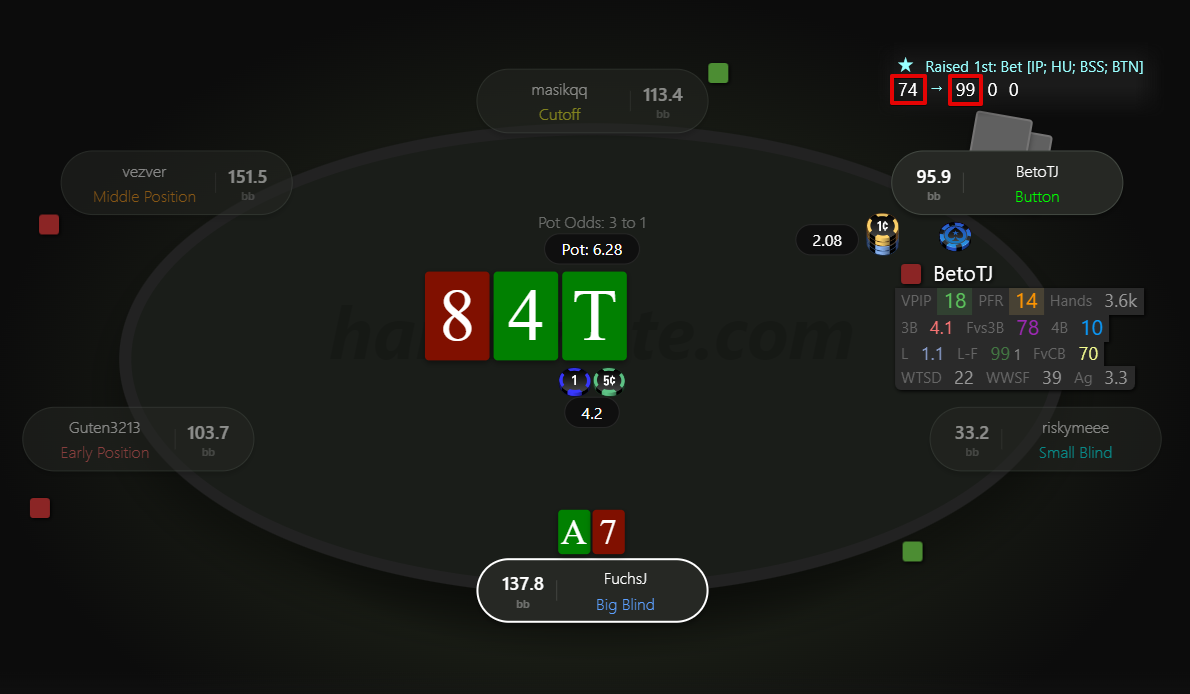
However, against an opponent like this, a bluff check-raise should be used as frequently as possible. We can see that up until the current hand, being in position, this player has made a continuation bet 74% of the time and folded every time facing a raise.
In this case, our hand strength becomes irrelevant, and in the long run, the bluff check-raise will simply print money for us.
# How often your opponent folds on the turn.
When planning a bluff check-raise on the flop, pay attention to how often your opponent folds to a raise and how often they fold to bets on subsequent streets. Some players rarely fold to a check-raise on the flop but then frequently fold to further aggression on the turn or river.
Against such opponents, the bluff check-raise on the flop can still be effective. However, to make them fold their hands, you’ll need to continue applying pressure on subsequent streets.
In this case, it’s better to semi-bluff and choose hands that can improve to a strong combination since playing a large pot with a pure bluff is not a good idea.
Example:
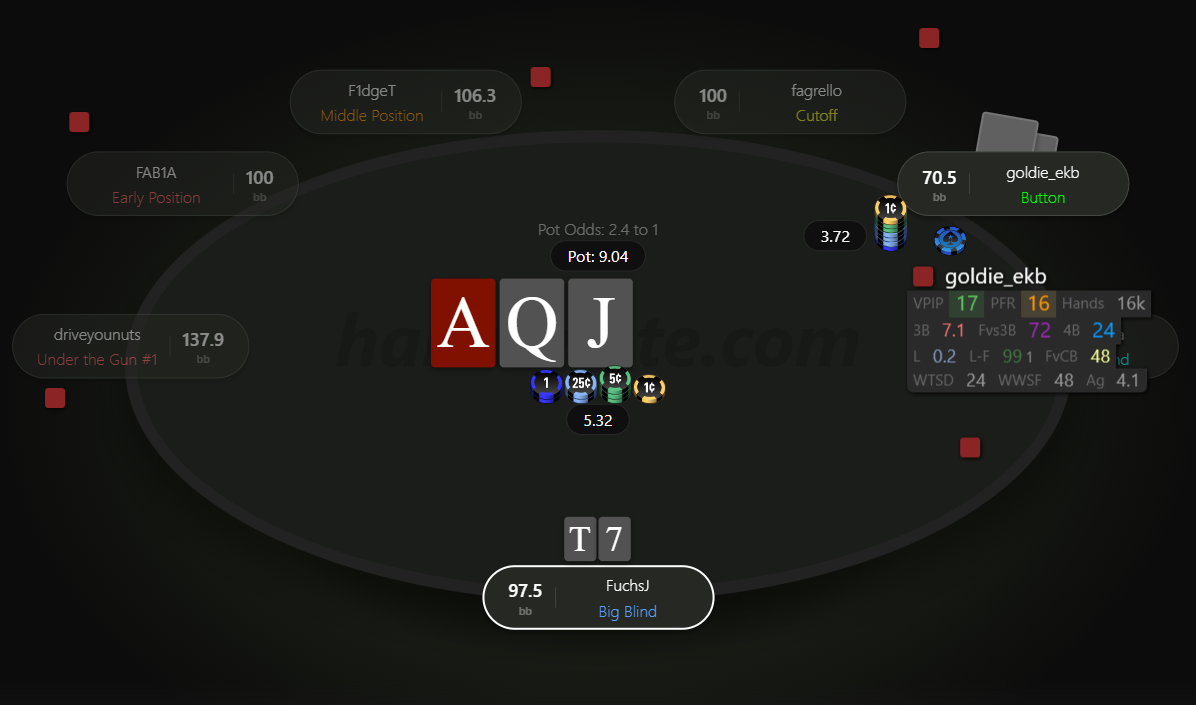
A player on the Button raises preflop, and we make a call in the Big Blind with T7 suited. On the flop, we’ve got a flush draw and a gutshot, and our opponent makes a continuation bet. Now it’s our turn. Of course, folding our hand is not an option, but what would be our best play?
We can just call and try to improve on the turn, or we can go for a check-raise to force our opponent to fold. To make the optimal decision, let’s open the popup and study our opponent’s tendencies:
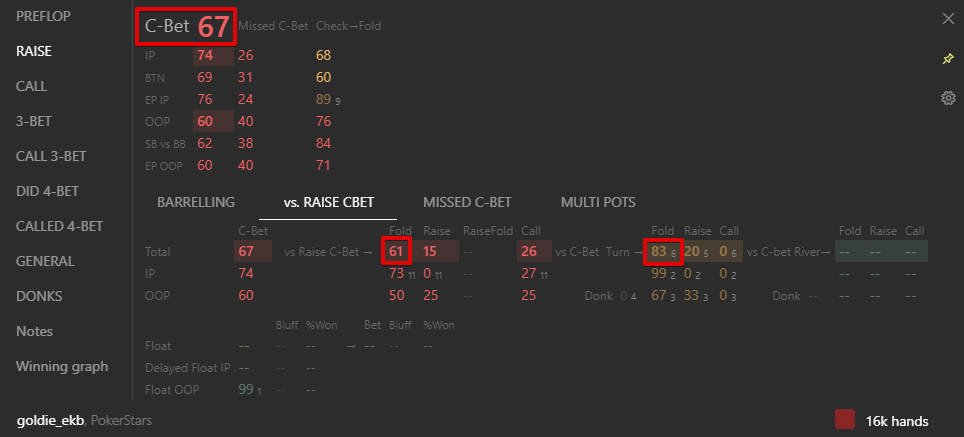
In the popup, we can see that our opponent’s flop continuation bet frequency is 67%, and then this player folds to a raise 61% of the time, which actually already makes the check-raise quite promising.
But the most notable thing is that, after calling a check-raise on the flop, our opponent folded to a subsequent bet on the turn 83% of the time, or 5 out of 6 instances.
Based on such statistics, I would definitely prefer to check-raise with a plan to bet again on any turn card, especially considering that with our hand, we can improve to a flush or a straight.
# Сontinuation bet size.
Most players use unbalanced bet sizes, making larger bets with strong hands and smaller bets with weak ones. Consequently, the smaller the size of the opponent’s continuation bet, the more you should lean towards check-raise bluffing.
Let’s examine the correlation between the continuation bet size and hand strength using Multi-player reports in Hand2Note 4. Thanks to this unique feature, we can accurately determine the tendencies of players who follow a similar style and build exploitative strategies against them.
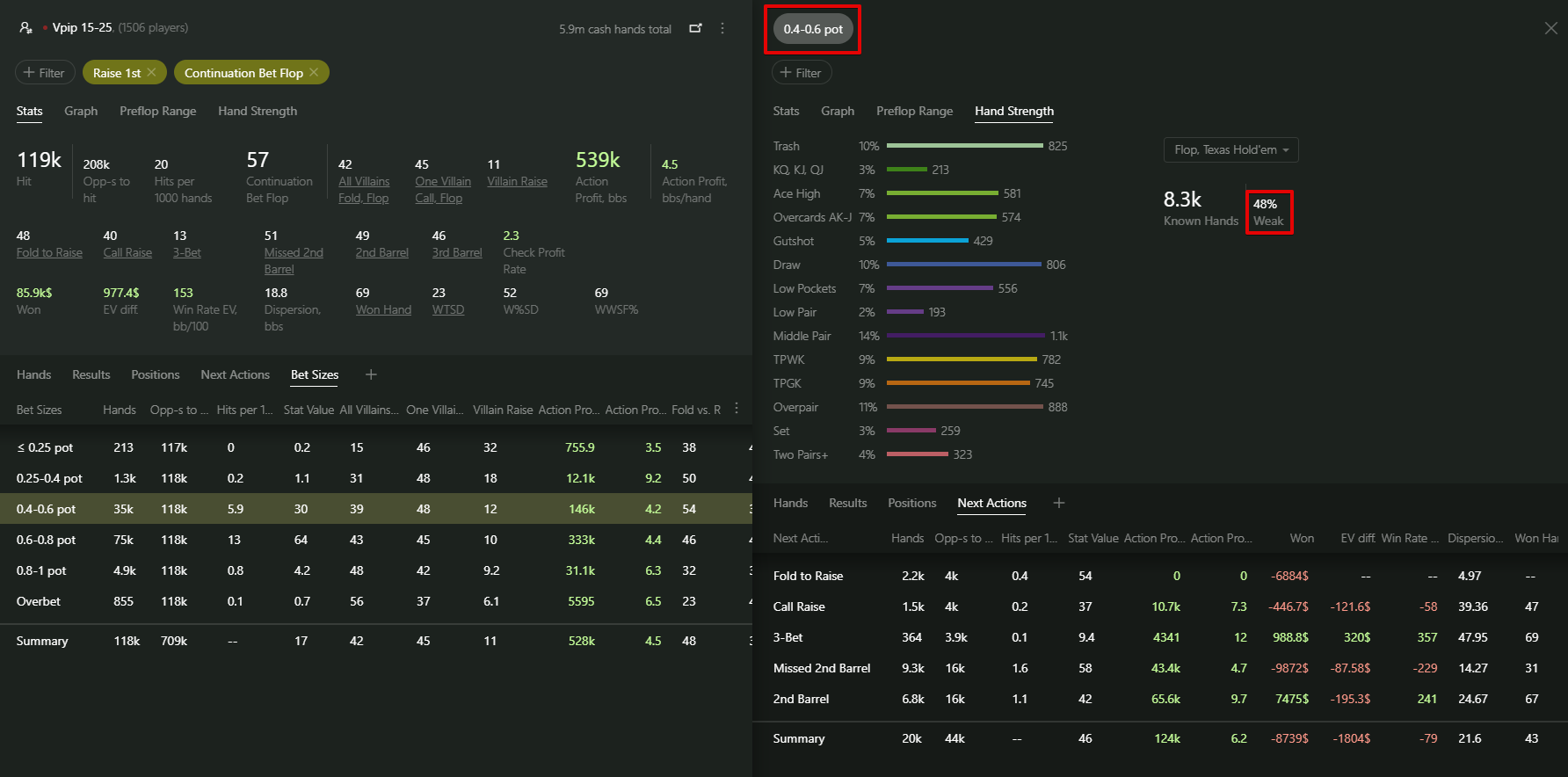
For this report, I selected tight regular players, with at least 1000 hands for each in my database, and applied “Raise 1st” and “Continuation Bet Flop” filters. We can see that when such a player makes a continuation bet on the flop choosing a size from 40% to 60% of the pot, weak hands comprise 48% of their range.
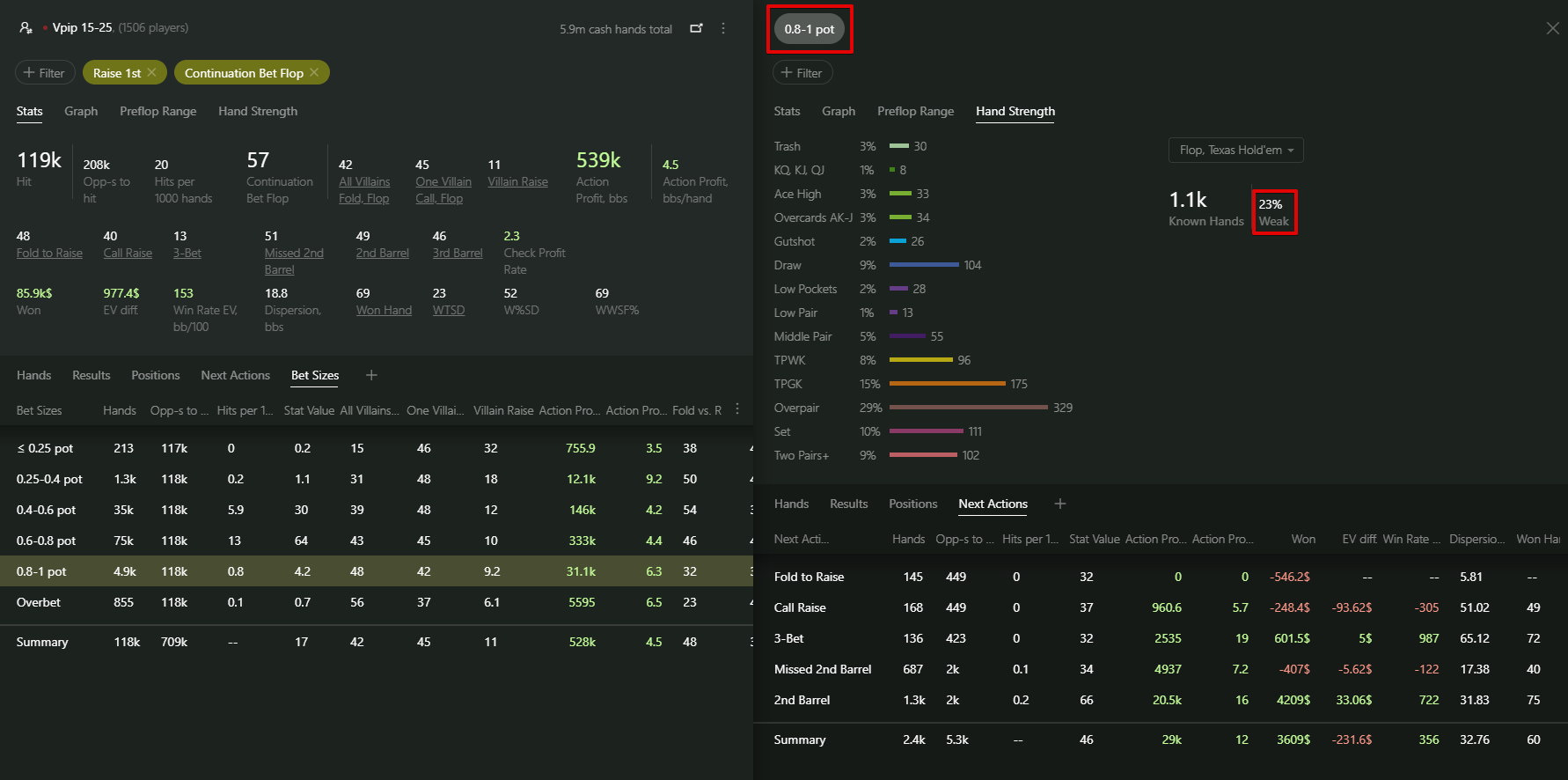
When such a player bets 80% to 100% of the pot, the number of weak hands in their range immediately halves to just 23%. Therefore, it’s more prudent to attack smaller bets of regular players with check-raises, whereas their larger bets should be approached with more caution.
# Number of players in the pot.
In heads-up pots, bluff check-raises will work more often than in multiway pots.
Firstly, when playing against two or more players, the probability of one of them having a strong hand increases.
Secondly, against multiple opponents, most players usually make continuation bets with stronger hands compared to when facing just one opponent. Let’s confirm this using Multiple-player reports in Hand2Note 4.
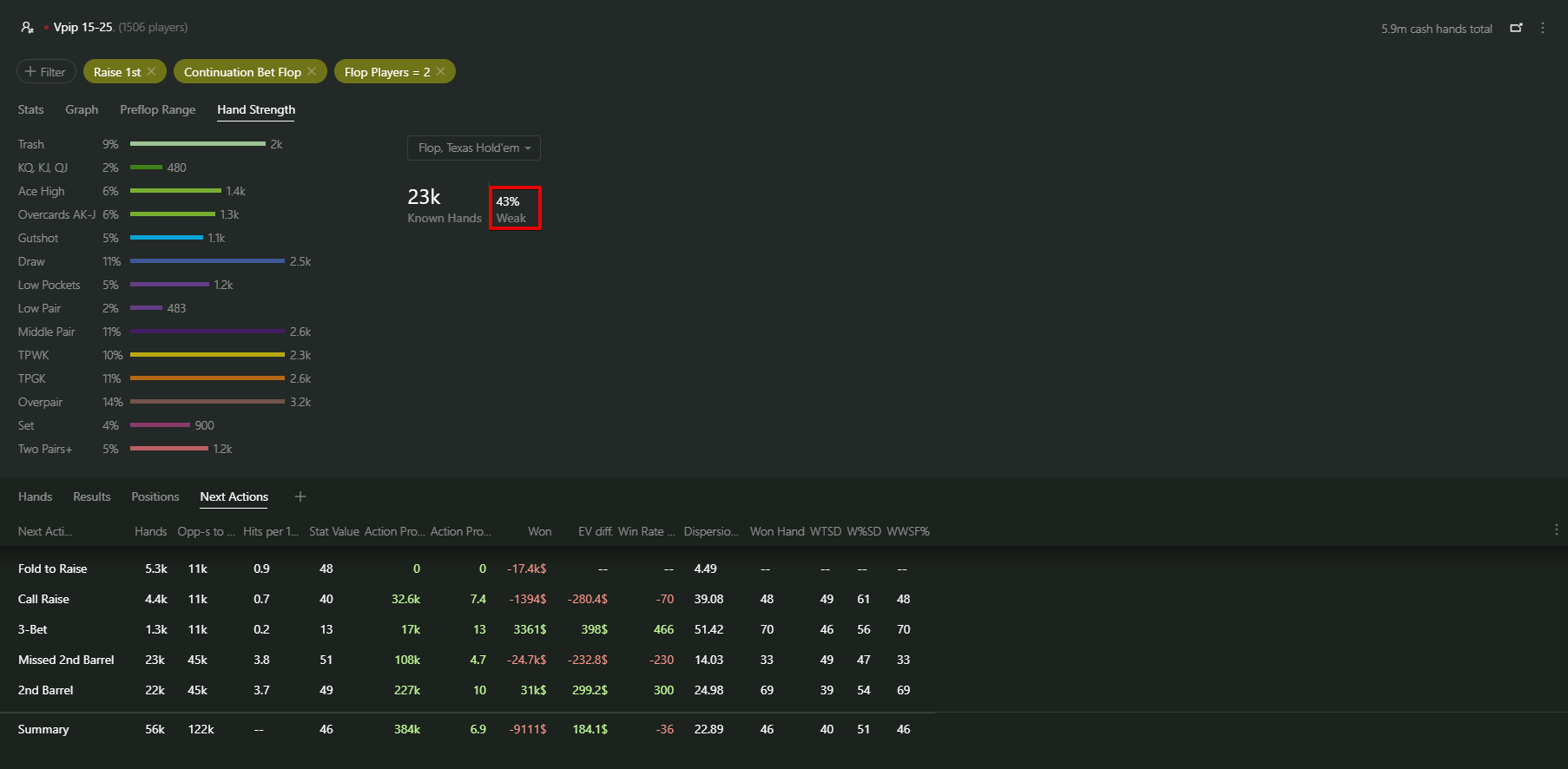
For this report, I took the same sample and applied the same filters as in the previous example. I also set the parameter “Number of players on the flop” to 2.
In the resulting report, we can notice that when facing only one opponent on the flop, regular players made a continuation bet with a weak hand in 43% of cases. Now, let’s change the value of the parameter “Number of players on the flop” from 2 to 3 and see how the trend will change:
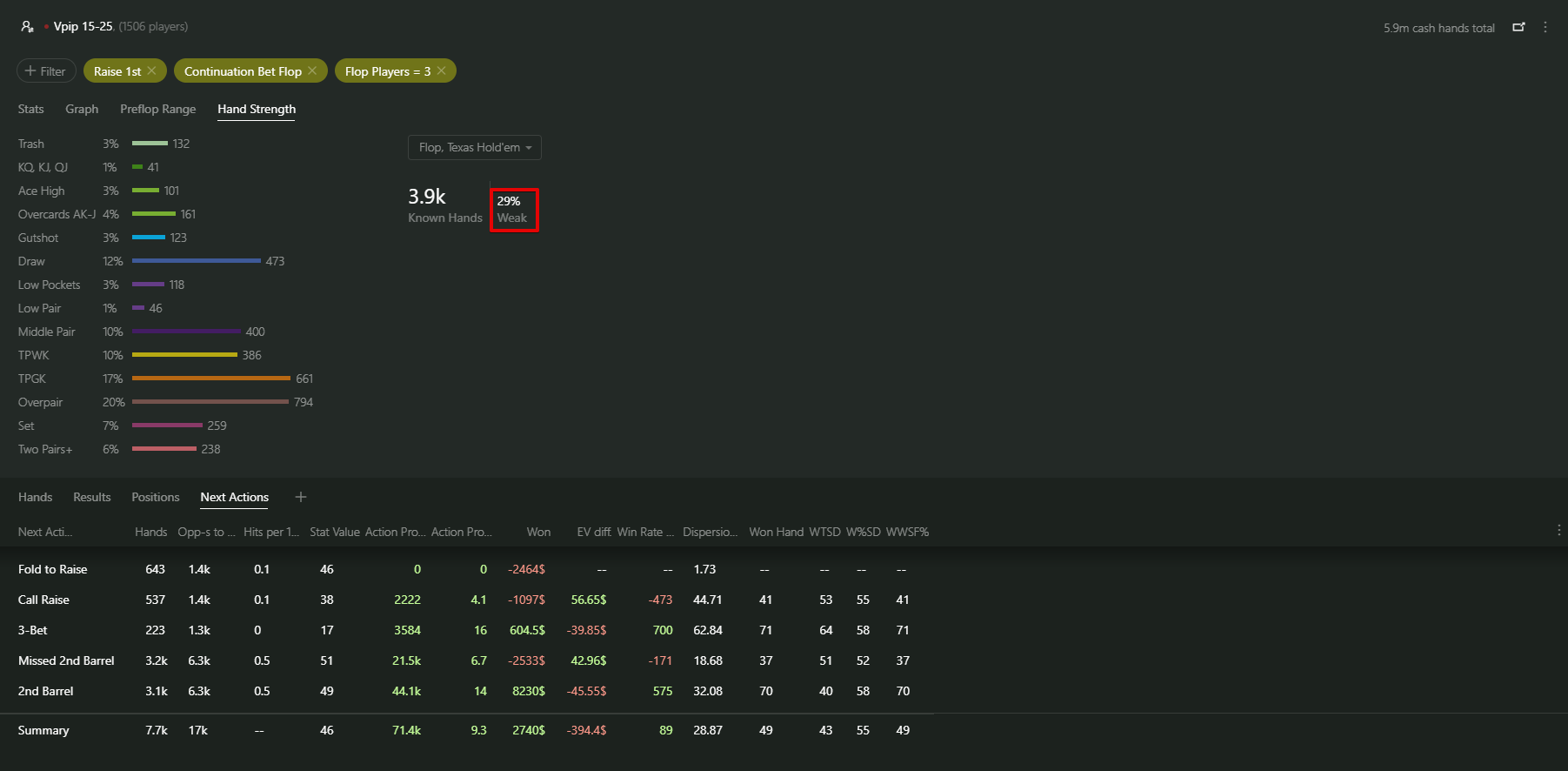
As we can see, in the range of the flop continuation bet made against two opponents, the proportion of weak hands is significantly lower, standing at only 29%. Consequently, the more players in the pot, the less advisable it is to resort to bluff check-raises.
A bluff check-raise is a powerful tool against continuation bets, and this move should definitely be part of your poker arsenal. However, remember that its successful use requires an understanding of your opponents’ tendencies, the ability to read them, and proper situation analysis.
With the help of Hand2Note 4, you can easily track statistics on your opponents, identify weaknesses in their play, and select suitable situations for bluff check-raises.
# When to Check-Raise Bluff on the Flop
A bluff check-raise on the flop is a simple yet highly effective poker move that can minimize your losses from the blinds and significantly increase your winnings without showdown.
Most often, the opportunity for a bluff check-raise arises when someone raises preflop, and you call in the Big Blind. Then, on the flop, you check, and the initial raiser makes a continuation bet. In such a situation, even if you don’t have a strong hand on the flop, you can still fight for the pot by check-raising as a bluff. However, when is it profitable to make such a move?
Table of Contents:
How often your opponent folds on the turn
For successful implementation of a bluff check-raise on the flop, it’s essential to consider the following key factors:
# Continuation bet frequency.
The more often your opponent makes a continuation bet on the flop, the higher the likelihood that they don’t have a strong hand. Hence, they’ll fold more frequently to a check-raise.
Let’s compare two players’ tendencies.

As shown in the screenshot above, Hand2Note 4 dynamic HUD shows that our opponent, when in position, makes a continuation bet on the flop 51% of the time and then folds to a check-raise 50% of the time. Against such an opponent, a bluff check-raise on the flop may not be very effective since their range won’t consist of many weak hands.

However, against an opponent like this, a bluff check-raise should be used as frequently as possible. We can see that up until the current hand, being in position, this player has made a continuation bet 74% of the time and folded every time facing a raise.
In this case, our hand strength becomes irrelevant, and in the long run, the bluff check-raise will simply print money for us.
# How often your opponent folds on the turn.
When planning a bluff check-raise on the flop, pay attention to how often your opponent folds to a raise and how often they fold to bets on subsequent streets. Some players rarely fold to a check-raise on the flop but then frequently fold to further aggression on the turn or river.
Against such opponents, the bluff check-raise on the flop can still be effective. However, to make them fold their hands, you’ll need to continue applying pressure on subsequent streets.
In this case, it’s better to semi-bluff and choose hands that can improve to a strong combination since playing a large pot with a pure bluff is not a good idea.
Example:

A player on the Button raises preflop, and we make a call in the Big Blind with T7 suited. On the flop, we’ve got a flush draw and a gutshot, and our opponent makes a continuation bet. Now it’s our turn. Of course, folding our hand is not an option, but what would be our best play?
We can just call and try to improve on the turn, or we can go for a check-raise to force our opponent to fold. To make the optimal decision, let’s open the popup and study our opponent’s tendencies:

In the popup, we can see that our opponent’s flop continuation bet frequency is 67%, and then this player folds to a raise 61% of the time, which actually already makes the check-raise quite promising.
But the most notable thing is that, after calling a check-raise on the flop, our opponent folded to a subsequent bet on the turn 83% of the time, or 5 out of 6 instances.
Based on such statistics, I would definitely prefer to check-raise with a plan to bet again on any turn card, especially considering that with our hand, we can improve to a flush or a straight.
# Сontinuation bet size.
Most players use unbalanced bet sizes, making larger bets with strong hands and smaller bets with weak ones. Consequently, the smaller the size of the opponent’s continuation bet, the more you should lean towards check-raise bluffing.
Let’s examine the correlation between the continuation bet size and hand strength using Multi-player reports in Hand2Note 4. Thanks to this unique feature, we can accurately determine the tendencies of players who follow a similar style and build exploitative strategies against them.

For this report, I selected tight regular players, with at least 1000 hands for each in my database, and applied “Raise 1st” and “Continuation Bet Flop” filters. We can see that when such a player makes a continuation bet on the flop choosing a size from 40% to 60% of the pot, weak hands comprise 48% of their range.

When such a player bets 80% to 100% of the pot, the number of weak hands in their range immediately halves to just 23%. Therefore, it’s more prudent to attack smaller bets of regular players with check-raises, whereas their larger bets should be approached with more caution.
# Number of players in the pot.
In heads-up pots, bluff check-raises will work more often than in multiway pots.
Firstly, when playing against two or more players, the probability of one of them having a strong hand increases.
Secondly, against multiple opponents, most players usually make continuation bets with stronger hands compared to when facing just one opponent. Let’s confirm this using Multiple-player reports in Hand2Note 4.

For this report, I took the same sample and applied the same filters as in the previous example. I also set the parameter “Number of players on the flop” to 2.
In the resulting report, we can notice that when facing only one opponent on the flop, regular players made a continuation bet with a weak hand in 43% of cases. Now, let’s change the value of the parameter “Number of players on the flop” from 2 to 3 and see how the trend will change:

As we can see, in the range of the flop continuation bet made against two opponents, the proportion of weak hands is significantly lower, standing at only 29%. Consequently, the more players in the pot, the less advisable it is to resort to bluff check-raises.
A bluff check-raise is a powerful tool against continuation bets, and this move should definitely be part of your poker arsenal. However, remember that its successful use requires an understanding of your opponents’ tendencies, the ability to read them, and proper situation analysis.
With the help of Hand2Note 4, you can easily track statistics on your opponents, identify weaknesses in their play, and select suitable situations for bluff check-raises.















